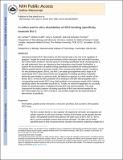| dc.contributor.author | London, Nir | |
| dc.contributor.author | Gulla, Stefano | |
| dc.contributor.author | Keating, Amy E. | |
| dc.contributor.author | Schueler-Furman, Ora | |
| dc.date.accessioned | 2014-01-31T17:35:47Z | |
| dc.date.available | 2014-01-31T17:35:47Z | |
| dc.date.issued | 2012-06 | |
| dc.date.submitted | 2012-06 | |
| dc.identifier.issn | 0006-2960 | |
| dc.identifier.issn | 1520-4995 | |
| dc.identifier.uri | http://hdl.handle.net/1721.1/84624 | |
| dc.description.abstract | Interactions between Bcl-2-like proteins and BH3 domains play a key role in the regulation of apoptosis. Despite the overall structural similarity of their interaction with helical BH3 domains, Bcl-2-like proteins exhibit an intricate spectrum of binding specificities whose underlying basis is not well understood. Here, we characterize these interactions using Rosetta FlexPepBind, a protocol for the prediction of peptide binding specificity that evaluates the binding potential of different peptides based on structural models of the corresponding peptide–receptor complexes. For two prominent players, Bcl-xL and Mcl-1, we obtain good agreement with a large set of experimental SPOT array measurements and recapitulate the binding specificity of peptides derived by yeast display in a previous study. We extend our approach to a third member of this family, Bcl-2: we test our blind prediction of the binding of 180 BIM-derived peptides with a corresponding experimental SPOT array. Both prediction and experiment reveal a Bcl-2 binding specificity pattern that resembles that of Bcl-xL. Finally, we extend this application to accurately predict the specificity pattern of additional human BH3-only derived peptides. This study characterizes the distinct patterns of binding specificity of BH3-only derived peptides for the Bcl-2 like proteins Bcl-xL, Mcl-1, and Bcl-2 and provides insight into the structural basis of determinants of specificity. | en_US |
| dc.description.sponsorship | National Institutes of Health (U.S.) (R01GM84181) | en_US |
| dc.language.iso | en_US | |
| dc.publisher | American Chemical Society (ACS) | en_US |
| dc.relation.isversionof | http://dx.doi.org/10.1021/bi3003567 | en_US |
| dc.rights | Article is made available in accordance with the publisher's policy and may be subject to US copyright law. Please refer to the publisher's site for terms of use. | en_US |
| dc.source | PMC | en_US |
| dc.title | In-silico and in-vitro elucidation of BH3 binding specificity towards Bcl-2 | en_US |
| dc.type | Article | en_US |
| dc.identifier.citation | London, Nir, Stefano Gulla, Amy E. Keating, and Ora Schueler-Furman. “In Silico and in Vitro Elucidation of BH3 Binding Specificity toward Bcl-2.” Biochemistry 51, no. 29 (July 24, 2012): 5841-5850. | en_US |
| dc.contributor.department | Massachusetts Institute of Technology. Department of Biology | en_US |
| dc.contributor.mitauthor | Gulla, Stefano | en_US |
| dc.contributor.mitauthor | Keating, Amy E. | en_US |
| dc.relation.journal | Biochemistry | en_US |
| dc.eprint.version | Author's final manuscript | en_US |
| dc.type.uri | http://purl.org/eprint/type/JournalArticle | en_US |
| eprint.status | http://purl.org/eprint/status/PeerReviewed | en_US |
| dspace.orderedauthors | London, Nir; Gulla, Stefano; Keating, Amy E.; Schueler-Furman, Ora | en_US |
| dc.identifier.orcid | https://orcid.org/0000-0003-4074-8980 | |
| mit.license | PUBLISHER_POLICY | en_US |
| mit.metadata.status | Complete | |
